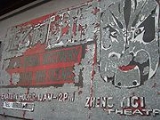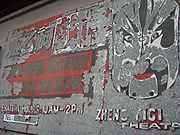
Chinese theatre
Encyclopedia

Chinese opera
Chinese opera is a popular form of drama and musical theatre in China with roots going back as far as the third century CE...
although this normally refers specifically to the more well-known forms such as Beijing Opera
Beijing opera
Peking opera or Beijing opera is a form of traditional Chinese theatre which combines music, vocal performance, mime, dance and acrobatics. It arose in the late 18th century and became fully developed and recognized by the mid-19th century. The form was extremely popular in the Qing Dynasty court...
and Cantonese Opera
Cantonese opera
Cantonese opera is one of the major categories in Chinese opera, originating in southern China's Cantonese culture. It is popular in Guangdong, Guangxi, Hong Kong, Macau, Singapore and Malaysia. Like all versions of Chinese opera, it is a traditional Chinese art form, involving music, singing,...
, there have been many other forms of theatre in China.
Classical Chinese theatre
There are references to theatrical entertainments in China as early as the Shang DynastyShang Dynasty
The Shang Dynasty or Yin Dynasty was, according to traditional sources, the second Chinese dynasty, after the Xia. They ruled in the northeastern regions of the area known as "China proper" in the Yellow River valley...
; they often involved happiness, mimes, and acrobatic displays.
The Tang Dynasty
Tang Dynasty
The Tang Dynasty was an imperial dynasty of China preceded by the Sui Dynasty and followed by the Five Dynasties and Ten Kingdoms Period. It was founded by the Li family, who seized power during the decline and collapse of the Sui Empire...
is sometimes known as "The Age of 1000 Entertainments". During this era, Ming Huang formed an acting school known as The Pear Garden
Pear Garden
The Pear Garden or Lìyuán was the first known royal acting and musical academy in China. It was founded during the Tang Dynasty by Emperor Xuanzong...
to produce a form of drama that was primarily musical. That is why actors are commonly called "Children of the Pear Garden."
Shadow play
During the Dynasty of Empress Ling, shadow puppetryShadow play
Shadow play or shadow puppetry Shadow puppets have a long history in China, India, Turkey and Java, and as a popular form of entertainment for both children and adults in many countries around the world. A shadow puppet is a cut-out figure held between a source of light and a translucent screen...
first emerged as a recognized form of theatre in China. There were two distinct forms of shadow puppetry, Pekingese (northern) and Cantonese (southern). The two styles were differentiated by the method of making the puppets and the positioning of the rods on the puppets, as opposed to the type of play
Play (theatre)
A play is a form of literature written by a playwright, usually consisting of scripted dialogue between characters, intended for theatrical performance rather than just reading. There are rare dramatists, notably George Bernard Shaw, who have had little preference whether their plays were performed...
performed by the puppets. Both styles generally performed plays depicting great adventure and fantasy, rarely was this very stylized form of theatre used for political propaganda. Cantonese shadow puppets were the larger of the two. They were built using thick leather which created more substantial shadows. Symbolic color was also very prevalent; a black face represented honesty, a red one bravery. The rods used to control Cantonese puppets were attached perpendicular to the puppets’ heads. Thus, they were not seen by the audience when the shadow was created. Pekingese puppets were more delicate and smaller. They were created out of thin, translucent leather (usually taken from the belly of a donkey).They were painted with vibrant paints, thus they cast a very colorful shadow. The thin rods which controlled their movements were attached to a leather collar at the neck of the puppet. The rods ran parallel to the bodies of the puppet then turned at a ninety degree angle to connect to the neck. While these rods were visible when the shadow was cast, they laid outside the shadow of the puppet; thus they did not interfere with the appearance of the figure. The rods attached at the necks to facilitate the use of multiple heads with one body. When the heads were not being used, they were stored in a muslin book or fabric lined box. The heads were always removed at night. This was in keeping with the old superstition that if left intact, the puppets would come to life at night. Some puppeteers went so far as to store the heads in one book and the bodies in another, to further reduce the possibility of reanimating puppets. Shadow puppetry is said to have reached its highest point of artistic development in the eleventh century before becoming a tool of the government.
Chinese opera
In the Song DynastySong Dynasty
The Song Dynasty was a ruling dynasty in China between 960 and 1279; it succeeded the Five Dynasties and Ten Kingdoms Period, and was followed by the Yuan Dynasty. It was the first government in world history to issue banknotes or paper money, and the first Chinese government to establish a...
, there were many popular plays involving acrobatics and music. These developed in the Yuan Dynasty
Yuan Dynasty
The Yuan Dynasty , or Great Yuan Empire was a ruling dynasty founded by the Mongol leader Kublai Khan, who ruled most of present-day China, all of modern Mongolia and its surrounding areas, lasting officially from 1271 to 1368. It is considered both as a division of the Mongol Empire and as an...
into a more sophisticated form with a four or five act structure. Yuan drama spread across China and diversified into numerous regional forms, the best known of which is Beijing Opera, which is still popular today.
Xiangsheng
XiangshengXiangsheng
Xiangsheng , sometimes translated as crosstalk, is a traditional Chinese comedic performance in the form of a dialogue between two performers, or, much less often, a solo monologue or, even less frequently, a multi-player talk show. The language, rich in puns and allusions, is delivered in a rapid,...
is a traditional Chinese comedic performance in the form of a monologue or a dialogue.
Classical drama
- Shih Chung-wen. The Golden Age of Chinese Drama (Princeton University Press, 1976).
Shadow play
- Jacques Pimpaneau. Des poupées à l'ombre: le théâtre d'ombres et de poupées en Chine. Paris : Université Paris 7e, 1977.
Modern Chinese theatre
- Obraszow, Sergei. Theater in China. Berlin, Henschelverlag, 1963.
- Mackerras, Colin. The Chinese Theatre in Modern Times. From 1840 to the Present Day. London, Thames & Hudson, 1975.
- Zhao, Henry Y. H. Towards a Modern Zen Theatre: Gao Xingjian and Chinese Theatre Experimentalism. University of London: School of Oriental and African Studies, 2000.
- Chen, Xiaomei. Acting the Right Part. Honolulu, University of Hawaii Press, 2002.
- Riley, Jo. Chinese Theatre and the Actor in Performance. Cambridge, Cambridge University PressCambridge University PressCambridge University Press is the publishing business of the University of Cambridge. Granted letters patent by Henry VIII in 1534, it is the world's oldest publishing house, and the second largest university press in the world...
, 1997, ISBN 0-521-57090-5.sdadasdasd

